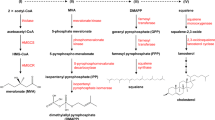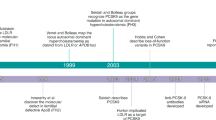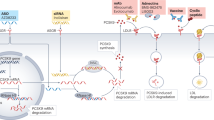Abstract
Plasma concentrations of HDL cholesterol are inversely correlated with risk of coronary heart disease, and low HDL-cholesterol levels are a risk factor even in patients aggressively treated for LDL reduction. Thus, there is great interest in targeting HDL cholesterol therapeutically. The existing approaches are limited in their ability to raise HDL-cholesterol levels, and there has, therefore, been a major focus on the development of novel therapies. The goal of new approaches is to either raise HDL-cholesterol levels or improve the function of HDL. Here, the current status of the development of novel therapies targeted toward HDL metabolism is reviewed.
Key Points
-
Current clinical approaches to treating low HDL-cholesterol levels are inadequate and new therapies are needed that either increase HDL-cholesterol levels or improve HDL function
-
HDL protects against atherosclerosis by promoting the process of reverse cholesterol transport, as well as potentially through additional mechanisms such as anti-inflammatory, antioxidative, antithrombotic, and nitric-oxide-promoting properties
-
Promotion of macrophage cholesterol efflux is a desirable target for development of novel therapies and might be achieved through targeting the liver X receptor or the peroxisome proliferative activated receptors
-
Apolipoprotein A-I mimetic peptides present a potential biological method for increasing HDL function as an approach to reducing atherosclerosis
-
The effect of a novel therapeutic approach on the plasma HDL-cholesterol level alone is not an adequate predictor of the potential clinical benefit
This is a preview of subscription content, access via your institution
Access options
Subscribe to this journal
Receive 12 print issues and online access
$209.00 per year
only $17.42 per issue
Buy this article
- Purchase on Springer Link
- Instant access to full article PDF
Prices may be subject to local taxes which are calculated during checkout
Similar content being viewed by others
References
Grundy SM et al. (2004) Implications of recent clinical trials for the National Cholesterol Education Program Adult Treatment Panel III guidelines. Circulation 110: 227–239
Cannon CP et al. (2004) Intensive versus moderate lipid lowering with statins after acute coronary syndromes. N Engl J Med 350: 1495–1504
LaRosa JC et al. (2005) Intensive lipid lowering with atorvastatin in patients with stable coronary disease. N Engl J Med 352: 1425–1435
Ashen MD and Blumenthal RS (2005) Clinical practice: low HDL cholesterol levels. N Engl J Med 353: 1252–1260
Lewis GF and Rader DJ (2005) New insights into the regulation of HDL metabolism and reverse cholesterol transport. Circ Res 96: 1221–1232
Timmins JM et al. (2005) Targeted inactivation of hepatic Abca1 causes profound hypoalphalipoproteinemia and kidney hypercatabolism of apoA-I. J Clin Invest 115: 1333–1342
Brunham LR et al. (2006) Intestinal ABCA1 directly contributes to HDL biogenesis in vivo . J Clin Invest 116: 1052–1062
Hobbs HH and Rader DJ (1999) ABC1: connecting yellow tonsils, neuropathy, and very low HDL. J Clin Invest 104: 1015–1017
Wang N et al. (2004) ATP-binding cassette transporters G1 and G4 mediate cellular cholesterol efflux to high-density lipoproteins. Proc Natl Acad Sci USA 101: 9774–9779
Kennedy MA et al. (2005) ABCG1 has a critical role in mediating cholesterol efflux to HDL and preventing cellular lipid accumulation. Cell Metab 1: 121–131
Li AC and Glass CK (2004) PPAR- and LXR-dependent pathways controlling lipid metabolism and the development of atherosclerosis. J Lipid Res 45: 2161–2173
Jian B et al. (1998) Scavenger receptor class B type I as a mediator of cellular cholesterol efflux to lipoproteins and phospholipid acceptors. J Biol Chem 273: 5599–5606
Zhang Y (2005) Hepatic expression of scavenger receptor class B type I (SR-BI) is a positive regulator of macrophage reverse cholesterol transport in vivo . J Clin Invest 115: 2870–2874
Schwartz CC et al. (2004) Lipoprotein cholesteryl ester production transfer and output in vivo in humans. J Lipid Res 45: 1594–1607
Barter PJ et al. (2004) Antiinflammatory properties of HDL. Circ Res 95: 764–772
Moore RE et al. (2005) Increased atherosclerosis in mice lacking apolipoprotein A-I attributable to both impaired reverse cholesterol transport and increased inflammation. Circ Res 97: 763–771
Ansell BJ et al. (2003) Inflammatory/antiinflammatory properties of high-density lipoprotein distinguish patients from control subjects better than high-density lipoprotein cholesterol levels and are favorably affected by simvastatin treatment. Circulation 108: 2751–2756
Mineo C et al. (2006) Endothelial and antithrombotic actions of HDL. Circ Res 98: 1352–1364
Baigent C et al. (2005) Efficacy and safety of cholesterol-lowering treatment: prospective meta-analysis of data from 90,056 participants in 14 randomised trials of statins. Lancet 366: 1267–1278
Robins SJ and Bloomfield HE (2006) Fibric acid derivatives in cardiovascular disease prevention: results from the large clinical trials. Curr Opin Lipidol 17: 431–439
Shepherd J et al. (2005) Nicotinic acid in the management of dyslipidaemia associated with diabetes and metabolic syndrome: a position paper developed by a European Consensus Panel. Curr Med Res Opin 21: 665–682
Carlson LA (2005) Nicotinic acid: the broad-spectrum lipid drug: a 50th anniversary review. J Intern Med 258: 94–114
Brown ML et al. (1989) Molecular basis of lipid transfer protein deficiency in a family with increased high-density lipoproteins. Nature 342: 448–451
Inazu A et al. (1990) Increased high-density lipoprotein levels caused by a common cholesteryl-ester transfer protein gene mutation. N Engl J Med 323: 1234–1238
Barter PJ et al. (2003) Cholesteryl ester transfer protein: a novel target for raising HDL and inhibiting atherosclerosis. Arterioscler Thromb Vasc Biol 23: 160–167
de Grooth GJ et al. (2004) A review of CETP and its relation to atherosclerosis. J Lipid Res 45: 1967–1974
de Grooth GJ et al. (2002) Efficacy and safety of a novel cholesteryl ester transfer protein inhibitor JTT-705 in humans: a randomized phase II dose-response study. Circulation 105: 2159–2165
Kuivenhoven JA (2005) Effectiveness of inhibition of cholesteryl ester transfer protein by JTT-705 in combination with pravastatin in type II dyslipidemia. Am J Cardiol 95: 1085–1088
Clark RW et al. (2004) Raising high-density lipoprotein in humans through inhibition of cholesteryl ester transfer protein: an initial multidose study of torcetrapib. Arterioscler Thromb Vasc Biol 24: 490–497
Brousseau ME et al. (2004) Effects of an inhibitor of cholesteryl ester transfer protein on HDL cholesterol. N Engl J Med 350: 1505–1515
Davidson M et al. (2006) Efficacy and safety of a novel cholesteryl ester transfer protein inhibitor torcetrapib when administered with and without atorvastatin to subjects with a low level of high-density lipoprotein cholesterol. J Am Coll Cardiol 48: 1782–1790
Thuren T et al. (2005) Torcetrapib combined with atorvastatin raises HDL-C, lowers LDL-C, and is well tolerated: Results from a phase 2 dose-ranging clinical trial [abstract]. Circulation 112 (Suppl): aSII–I179
Bays H et al. (2005) Torcetrapib/atorvastatin combination therapy. Expert Rev Cardiovasc Ther 3: 789–820
ClinicalTrials.gov [http://www.clinicaltrials.gov/ct/show/NCT00134264?order=3]
Ikewaki K et al. (1993) Delayed catabolism of high density lipoprotein apolipoproteins A-I and A-II in human cholesteryl ester transfer protein deficiency. J Clin Invest 92: 1650–1658
Ikewaki K et al. (1995) Increased catabolic rate of low density lipoproteins in humans with cholesteryl ester transfer protein deficiency. J Clin Invest 96: 1573–1581
Brousseau ME et al. (2005) Effects of cholesteryl ester transfer protein inhibition on high-density lipoprotein subspecies apolipoprotein A-I metabolism and fecal sterol excretion. Arterioscler Thromb Vasc Biol 25: 1057–1064
Millar JS et al. (2006) Effects of the cholesteryl ester transfer protein inhibitor torcetrapib on apolipoprotein B100 metabolism in humans. Arterioscler Thromb Vasc Biol 26: 1350–1356
Kee P (2006) Effect of inhibiting cholesteryl ester transfer protein on the kinetics of high-density lipoprotein cholesteryl ester transport in plasma: in vivo studies in rabbits. Arterioscler Thromb Vasc Biol 26: 884–890
Ishigami M et al. (1994) Large and cholesteryl ester-rich high-density lipoproteins in cholesteryl ester transfer protein (CETP) deficiency can not protect macrophages from cholesterol accumulation induced by acetylated low-density lipoproteins. J Biochem (Tokyo) 116: 257–262
Matsuura F et al. (2006) HDL from CETP-deficient subjects shows enhanced ability to promote cholesterol efflux from macrophages in an apoE- and ABCG1-dependent pathway. J Clin Invest 116: 1435–1442
Rader DJ (2004) Inhibition of cholesteryl ester transfer protein activity: a new therapeutic approach to raising high-density lipoprotein. Curr Atheroscler Rep 6: 398–405
Hirano K et al. (1997) Genetic cholesteryl ester transfer protein deficiency is extremely frequent in the Omagari area of Japan: marked hyperalphalipoproteinemia caused by CETP gene mutation is not associated with longevity. Arterioscler Thromb Vasc Biol 17: 1053–1059
Hirano K et al. (1995) Atherosclerotic disease in marked hyperalphalipoproteinemia. Arterioscler Thromb Vasc Biol 15: 1849–1856
Sakai N et al. (1995) Frequency of exon 15 missense mutation (442D:G) in cholesteryl ester transfer protein gene in hyperalphalipoproteinemic Japanese subjects. Atherosclerosis 114: 139–145
Moriyama Y et al. (1998) A low prevalence of coronary heart disease among subjects with increased high-density lipoprotein cholesterol levels including those with plasma cholesteryl ester transfer protein deficiency. Prev Med 27: 659–667
Curb JD et al. (2004) A prospective study of HDL-C and cholesteryl ester transfer protein gene mutations and the risk of coronary heart disease in the elderly. J Lipid Res 45: 948–953
Boekholdt SM and Thompson JF (2003) Natural genetic variation as a tool in understanding the role of CETP in lipid levels and disease. J Lipid Res 44: 1080–1093
Boekholdt SM et al. (2005) Cholesteryl ester transfer protein TaqIB variant, high-density lipoprotein cholesterol levels, cardiovascular risk, and efficacy of pravastatin treatment: individual patient meta-analysis of 13,677 subjects. Circulation 111: 278–287
Boekholdt SM et al. (2004) Plasma levels of cholesteryl ester transfer protein and the risk of future coronary artery disease in apparently healthy men and women: the prospective EPIC (European Prospective Investigation into Cancer and nutrition)-Norfolk population study. Circulation 110: 1418–1423
Joyce CW et al. (2002) The ATP binding cassette transporter A1 (ABCA1) modulates the development of aortic atherosclerosis in C57BL/6 and apoE-knockout mice. Proc Natl Acad Sci USA 99: 407–412
Linsel-Nitschke P and Tall AR (2005) HDL as a target in the treatment of atherosclerotic cardiovascular disease. Nat Rev Drug Discov 4: 193–205
Naik SU et al. (2006) Pharmacological activation of liver X receptors promotes reverse cholesterol transport in vivo . Circulation 113: 90–97
Joseph SB et al. (2002) Synthetic LXR ligand inhibits the development of atherosclerosis in mice. Proc Natl Acad Sci USA 99: 7604–7609
Levin N et al. (2005) Macrophage liver X receptor is required for antiatherogenic activity of LXR agonists. Arterioscler Thromb Vasc Biol 25: 135–142
Groot PH et al. (2005) Synthetic LXR agonists increase LDL in CETP species. J Lipid Res 46: 2182–2191
Chinetti G et al. (2001) PPAR-alpha and PPAR-gamma activators induce cholesterol removal from human macrophage foam cells through stimulation of the ABCA1 pathway. Nat Med 7: 53–58
Li AC et al. (2004) Differential inhibition of macrophage foam-cell formation and atherosclerosis in mice by PPARalpha beta/delta and gamma. J Clin Invest 114: 1564–1576
Szapary PO et al. (2006) Effects of pioglitazone on lipoproteins inflammatory markers and adipokines in nondiabetic patients with metabolic syndrome. Arterioscler Thromb Vasc Biol 26: 182–188
Oliver WR Jr et al. (2001) A selective peroxisome proliferator-activated receptor delta agonist promotes reverse cholesterol transport. Proc Natl Acad Sci USA 98: 5306–5311
Sprecher DL et al. (2006) Triglyceride: high-density lipoprotein cholesterol effects in healthy subjects administered a peroxisome proliferator activated receptor δ agonist. Arterioscler Thromb Vasc Biol [doi:10.1161/01.ATV.0000252790.70572.0c]
Tunaru S et al. (2003) PUMA-G and HM74 are receptors for nicotinic acid and mediate its anti-lipolytic effect. Nat Med 9: 352–355
Pike NB (2005) Flushing out the role of GPR109A (HM74A) in the clinical efficacy of nicotinic acid. J Clin Invest 115: 3400–3403
Benyo Z et al. (2005) GPR109A (PUMA-G/HM74A) mediates nicotinic acid-induced flushing. J Clin Invest 115: 3634–3640
Cheng K et al. (2006) Antagonism of the prostaglandin D2 receptor 1 suppresses nicotinic acid-induced vasodilation in mice and humans. Proc Natl Acad Sci USA 103: 6682–6687
Tonstad S (2006) Rimonabant: a cannabinoid receptor blocker for the treatment of metabolic and cardiovascular risk factors. Nutr Metab Cardiovasc Dis 16: 156–162
Pi-Sunyer FX et al. (2006) Effect of rimonabant a cannabinoid-1 receptor blocker on weight and cardiometabolic risk factors in overweight or obese patients: RIO-North America: a randomized controlled trial. JAMA 295: 761–775
Despres JP et al. (2005) Effects of rimonabant on metabolic risk factors in overweight patients with dyslipidemia. N Engl J Med 353: 2121–2134
Van Gaal LF et al. (2005) Effects of the cannabinoid-1 receptor blocker rimonabant on weight reduction and cardiovascular risk factors in overweight patients: 1-year experience from the RIO-Europe study. Lancet 365: 1389–1397
Horvath TL (2006) The unfolding cannabinoid story on energy homeostasis: central or peripheral site of action? Int J Obes (Lond) 30 (Suppl 1): S30–S32
Bramlage P et al. (2006) Cardiovascular risk management by blocking the endocannabinoid system. Exp Clin Endocrinol Diabetes 114: 75–81
Gelfand EV and Cannon CP (2006) Rimonabant: a selective blocker of the cannabinoid CB1 receptors for the management of obesity smoking cessation and cardiometabolic risk factors. Expert Opin Investig Drugs 15: 307–315
Plump A et al. (1994) Human apolipoprotein A-I gene expression increases high density lipoprotein and suppresses atherosclerosis in the apolipoprotein E-deficient mouse. Proc Natl Acad Sci USA 91: 9607–9611
Tangirala RK et al. (1999) Regression of atherosclerosis induced by liver-directed gene transfer of apolipoprotein A-I in mice. Circulation 100: 1816–1822
Zhang Y (2003) Overexpression of apolipoprotein A-I promotes reverse transport of cholesterol from macrophages to feces in vivo . Circulation 108: 661–663
Nissen SE et al. (2003) Effect of recombinant ApoA-I Milano on coronary atherosclerosis in patients with acute coronary syndromes: a randomized controlled trial. JAMA 290: 2292–2300
Rader DJ (2003) High-density lipoproteins as an emerging therapeutic target for atherosclerosis. JAMA 290: 2322–2324
Navab M et al. (2005) Apolipoprotein A-I mimetic peptides. Arterioscler Thromb Vasc Biol 25: 1325–1331
Navab M et al. (2002) Oral administration of an Apo A-I mimetic Peptide synthesized from D-amino acids dramatically reduces atherosclerosis in mice independent of plasma cholesterol. Circulation 105: 290–292
Navab M et al. (2004) Oral D-4F causes formation of pre-beta high-density lipoprotein and improves high-density lipoprotein-mediated cholesterol efflux and reverse cholesterol transport from macrophages in apolipoprotein E-null mice. Circulation 109: 3215–3220
Nofer JR and Assmann G (2005) Atheroprotective effects of high-density lipoprotein-associated lysosphingolipids. Trends Cardiovasc Med 15: 265–271
Tolle M et al. (2005) Immunomodulator FTY720 induces eNOS-dependent arterial vasodilatation via the lysophospholipid receptor S1P3. Circ Res 96: 913–920
Pfizer News (online 2 December 2006) In interests of patient safety, pfizer stops all torcetrapib clinical trials; company has notified fda and is in the process of notifying all clinical investigators and other regulatory authorities (press release) [http://mediaroom.pfizer.com/index.php?s=press_releases&item=130] (accessed 12 December 2006)
Author information
Authors and Affiliations
Ethics declarations
Competing interests
Dr Rader has interactions with companies that are involved in discovering new therapies targeted to HDL. He has received grant/research support from AstraZeneca, Boehringer Ingelheim, Bristol Myers Squibb, Bruin Pharma, GlaxoSmithKline, KOS Pharmaceuticals, Merck and Co., Pfizer, Schering-Plough and Takeda.
He is/has been a consultant for Abbott, AstraZeneca, Boehringer Ingelheim, Bristol Myers Squibb, GlaxoSmithKline, Johnson & Johnson, KOS Pharmaceuticals, Merck and Co., Merck–Schering Plough, Pfizer, Reliant, sanofi-aventis, Schering-Plough, Takeda and Wyeth.
He has been on the speakers bureau/received honoraria from Abbott, AstraZeneca, Boehringer Ingelheim, Bristol Myers Squibb, GlaxoSmithKline, Johnson & Johnson, KOS Pharmaceuticals, Merck and Co., Merck–Schering Plough, Pfizer, Reliant, sanofi-aventis, Schering-Plough, Takeda and Wyeth.
Rights and permissions
About this article
Cite this article
Rader, D. Mechanisms of Disease: HDL metabolism as a target for novel therapies. Nat Rev Cardiol 4, 102–109 (2007). https://doi.org/10.1038/ncpcardio0768
Received:
Accepted:
Issue Date:
DOI: https://doi.org/10.1038/ncpcardio0768
This article is cited by
-
A novel gene regulator, pyrrole–imidazole polyamide targeting ABCA1 gene increases cholesterol efflux from macrophages and plasma HDL concentration
Journal of Molecular Medicine (2014)
-
Proprotein convertases in high-density lipoprotein metabolism
Biomarker Research (2013)
-
Myeloperoxidase and Atherosclerosis
Current Cardiovascular Risk Reports (2013)
-
Serum Opacity Factor Enhances HDL‐Mediated Cholesterol Efflux, Esterification and Anti Inflammatory Effects
Lipids (2010)
-
The refined structure of nascent HDL reveals a key functional domain for particle maturation and dysfunction
Nature Structural & Molecular Biology (2007)



